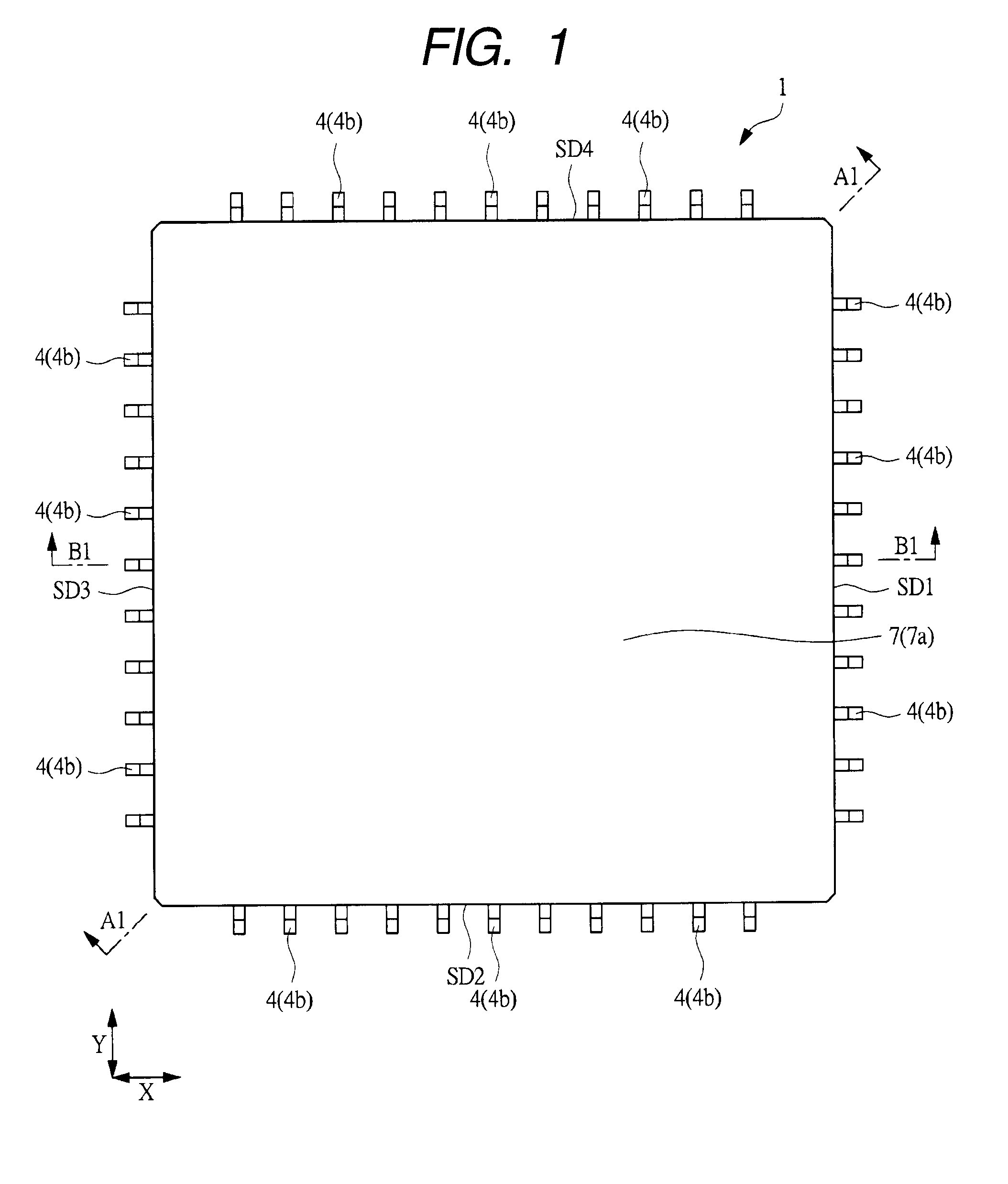Semiconductor device and method of manufacturing same
a technology of semiconductor devices and semiconductor chips, applied in semiconductor devices, semiconductor/solid-state device details, electrical equipment, etc., can solve the problems of gate insulating film deterioration, power consumption of semiconductor chips in a package, etc., and achieve the effect of improving the heat dissipation characteristics of semiconductor devices
- Summary
- Abstract
- Description
- Claims
- Application Information
AI Technical Summary
Benefits of technology
Problems solved by technology
Method used
Image
Examples
first embodiment
[0098]A semiconductor device in an embodiment of the present invention is explained with reference to the drawings.
[0099]FIG. 1 is a top view (plan view) of a semiconductor device 1, which is an embodiment of the present invention, FIG. 2 is a bottom view (back view) of the semiconductor device 1, and FIG. 3 is a plan perspective view (top view) of the semiconductor device 1 when a sealing resin part 7 is viewed perspectively. FIG. 4 is a partially enlarged view (partially enlarged plan perspective view) of FIG. 3, showing an enlarged view of the part in the vicinity of the center (a semiconductor chip 2 and a region in the vicinity thereof) in FIG. 3. FIG. 5 is a plan perspective view (partially enlarged plan perspective view) of the semiconductor device 1 when the semiconductor chip 2 and a bonding wire 5 are removed (when viewed perspectively). For easier understanding, the position at which the semiconductor chip 2 is mounted (arranged) is shown by a dotted line in FIG. 5. FIG. ...
second embodiment
[0175]FIG. 18 is a plan perspective view (top view) of semiconductor device 1a in the present embodiment, showing a plan perspective view of the semiconductor device 1a when the sealing resin part 7 is viewed perspectively. FIG. 19 is a partially enlarged view (partially enlarged plan perspective view) of FIG. 18, showing an enlarged view of the part in the vicinity of the center part in FIG. 19 (the semiconductor chip 2 and the region in the vicinity thereof). FIG. 20 is a plan perspective view (partially enlarged plan perspective view) of the semiconductor device 1a when the semiconductor chip 2 and the bonding wire 5 are removed (viewed perspectively) in FIG. 19. FIG. 18, FIG. 19, and FIG. 20 correspond to FIG. 3, FIG. 4, and FIG. 5 in the first embodiment, respectively. As in FIG. 5, in FIG. 20, the position where the semiconductor chip 2 is mounted (arranged) is shown by a dotted line for easier understanding. FIG. 21 to FIG. 23 are each a section view (side section view) of th...
third embodiment
[0194]FIG. 27 is a plan perspective view of essential parts of a semiconductor device of the present invention, corresponding to FIG. 20 in the above-mentioned second embodiment. The present embodiment corresponds to a modified example of the second embodiment. As in FIG. 20, in FIG. 27 also, a plan perspective view of essential parts of a semiconductor device is shown when the sealing resin part 7 is viewed perspectively and further, the semiconductor chip 2 and the bonding wire 5 are removed (viewed perspectively), and for easier understanding, the position where the semiconductor chip 2 is mounted (arranged) is shown by a dotted line.
[0195]In the first and second embodiments described above, the plane figure of the die pad 3 is a circle having a diameter greater than the width (width in the direction perpendicular to the direction in which the member 9 extends from the die pad 3 toward the heat dissipating plate 6) W1 of the member 9. In contrast to that, in the present embodimen...
PUM
 Login to View More
Login to View More Abstract
Description
Claims
Application Information
 Login to View More
Login to View More - R&D
- Intellectual Property
- Life Sciences
- Materials
- Tech Scout
- Unparalleled Data Quality
- Higher Quality Content
- 60% Fewer Hallucinations
Browse by: Latest US Patents, China's latest patents, Technical Efficacy Thesaurus, Application Domain, Technology Topic, Popular Technical Reports.
© 2025 PatSnap. All rights reserved.Legal|Privacy policy|Modern Slavery Act Transparency Statement|Sitemap|About US| Contact US: help@patsnap.com



